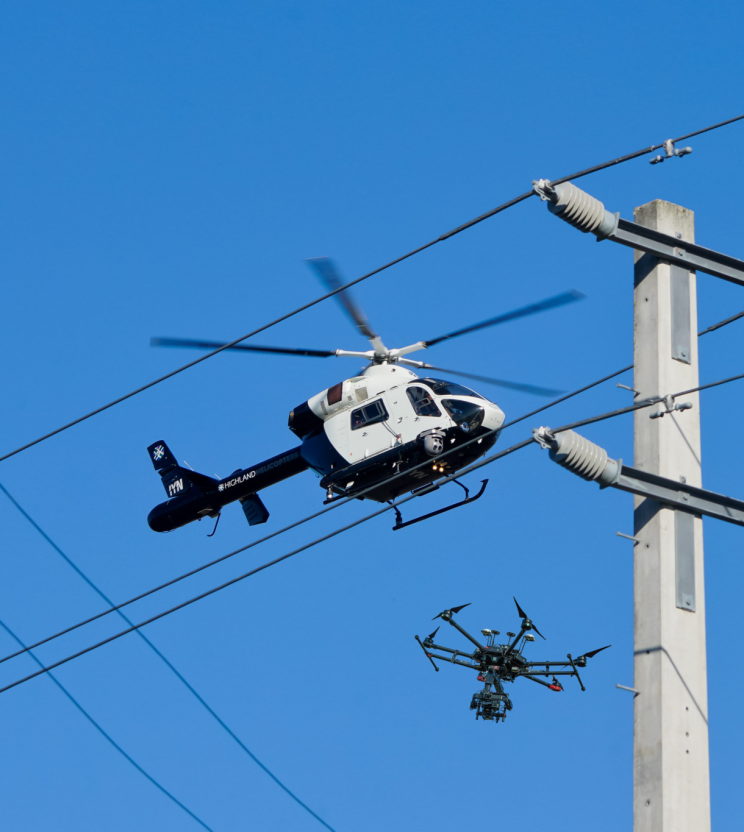Aerial Works
Check out what helicopter and drone operations are currently taking place

Check out what helicopter and drone operations are currently taking place
We use aircraft to check for faults, hazards and what conditions our lines are in.
Flying the lines is fast, cost-effective, and spots things that can’t be seen in our ground inspections, such as loose cross-arms or rot at the very top of a pole.
Any issues seen are logged for action, helping us maintain a safe, reliable network and uninterrupted supply for our customers.
All flights follow strict safety and operational procedures and are timed for after calving and lambing, with faults flights made as required.
We’re kicking off aerial surveys of around 43,000 power poles across the network! So look out for our flying visits in your area.
We’re using helicopters to fly over rural areas and drones for urban areas. We’re using drones to minimise disruption in urban areas because they’re quieter.
| Ōtorohanga | Taumarunui |
| Te Kūiti | Manunui |
| Piopio | Ōhura |
| Maniaiti / Benneydale | Ongarue |
| Taharoa | Kaitieke |
| Marokopa | Retaruke |
| Waikawau | Whakahoro |
| Waimihia | Raurimu |
| Mōkau | National Park |
| Wharepapa South | Ōwhango |
| Mangakino | Kuratau |
| Whakamaru | Western Bays |
| Tihoi | Tūrangi |
| Kinloch | Pukawa |
| Ātiamuri | Motouapa |
| Aria | Motutere |
| Mokauiti | Tauranga Taupo |
| Mangaotaki | Lake Rotoaira |
| Mairoa | Ohakune |
| Arohena | Rangataua |
| Waimahora | Tangiwai |
| Ruatiti | |
| Kakahi |

| Taharoa | National Park |
| Marokopa | Raurimu |
| Te Kūiti | Kakahi |
| Tūrangi | Mananui |
| Motuoapa | Ohakune |
| Tauranga Taupo | Taumaranui |
| Motutere | Ōhura |
| Matiere |

The inspections will provide TLC with valuable information on the condition of electrical assets, helping us to identify areas needing maintenance, repairs, or even replacement.
The aerial inspections replace the time-consuming process of our crews manually inspecting hard-to-reach electrical equipment such as power poles. In the past, this took our team up to 15 years to reach every pole on the network.
The aircraft will cover locations across the entire TLC network, traversing around 4,000km of power lines throughout the operation.
Northern areas of the network will be covered first, covering northern parts of the King Country, including Taharoa, Te Kūiti, Whakamaru, Ōtorohanga, Piopio, Mangakino, Arohena, Mōkau, and Marakopa.
Flights will move south once the northern areas are complete. Southern inspections will include Taumarunui, Tūrangi, Motuapa, Kuratau, Tongapōrutu, Ōwhango, Ōhura, National Park, and Ohakune.
We will use a helicopter to fly over rural areas and drones for urban areas. We are using quieter drone aircraft in urban areas to minimise disruption.
The aircraft will inspect around 43,000 poles on the TLC network, including cross-arms, insulator conductors, pole top switches, and transformers.
The visual footage taken of our equipment will be stored securely for use by our network team. The content will provide our team with valuable information on the condition of electrical assets on the network, helping us to identify areas needing maintenance, repairs, or even replacement.
No. The drones and helicopters will take photos of our electricity poles only. No private images or private information will be collected or stored. All data will be stored in our secure systems with cyber security protection.
Flights will take approximately 8 weeks to complete, weather permitting. Once we have collected the pole top footage, it will take our team 6 months to analyse it.
Weather permitting, the inspections will begin in late January.
We aim to complete inspections by June. Keep in mind that weather conditions may delay flights.
TLC has contracted Highland Helicopters to carry out inspections by helicopter and Outdoor Accuracy to complete them by drone.
Yes. Whilst TLC often uses helicopters to conduct inspections, this combined helicopter and drone operation with visual images over an intense, 8-week period is new.
The helicopter will conduct a high-level pass over the area where our power poles and lines are situated. This is to check for potential hazards and livestock within the area. It also gives landowners a heads up that a survey is in progress. Once the check is complete and no hazards and livestock have been identified, the helicopter will survey the electrical assets at a low level.
For more information on our aerial works, call our friendly customer team on 0800 367 546.